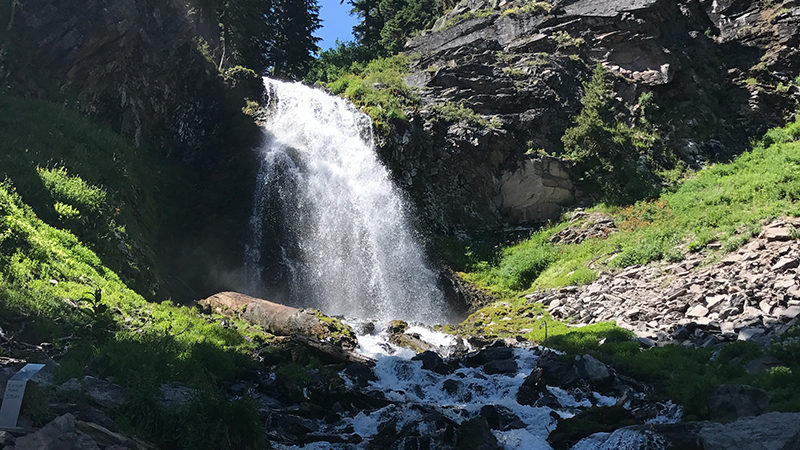
We definitely chase waterfalls.
There is nothing quite like the experience of standing at the base of a plunging waterfall, getting covered in misty droplets of cool water, wading in a cool pool below a thundering cascade, or even sitting beside a trickling late season waterfall as it trickles down a rocky cliff.
We’ve visited massive waterfalls like Grizzly Falls in Sequoia National Monument, Alberta Falls in Rocky Mountain National park, and McCloud Falls on the McCloud River. We’ve hiked to beautiful waterfalls like ‘Akaka Falls and Rainbow Falls in Hawaii, and McWay Falls and Pfeiffer Falls in Big Sur. We’ve even explored waterfalls in the Columbia River Gorge like Horsetail Falls, Multnomah Falls, La Tourell Falls, and Wahkeena Falls.
Needless to say, I was thrilled to discover there are two easy-access waterfalls in Crater Lake National Park: Vidae Falls and Plaikni Falls!
What’s interesting about the two falls is that neither Vidae Falls or Plaikni Falls are fed from Crater Lake. The source of water for both is snowmelt. According to interpretive signs in the national park, Crater Lake National Park’s high country receives an average yearly snowfall of 44 feet. This melting snow percolates through loose volcanic soil, hits an impermeable layer, and surfaces as a spring. One of those springs — Anderson Spring located just above Anderson Bluffs — is the origin of bubbling Sand Creek, which cascades down a rocky cliff as Plaikni Falls.
I guess it’s fitting that Plaikni is a Klamath Indian word meaning “from the high country.”
After taking in several stunning scenic viewpoints along Crater Lake’s historic Rim Drive and walking the easy Pinnacles Trail, we stopped at the Plaikni Falls trailhead, filled our Hydro flasks, and added a few snacks to our adventure packs before setting out on the trail.

The Plaikni Falls Trail
The Plaikni Falls Trail travels through a quiet old-growth Hemlock and Fir forest, along rocky bluffs flanking Sand Creek to the base of a 20 foot waterfall cascading down a glacier-carved cliff of petrified volcanic ash.
The trail, which opened in 2011, is an easy to moderate, 1.1 mile out-and-back trail that totals 2.2 miles round trip. We hiked this trail on a hot summer afternoon and really appreciated the spotty shade that covered most of the trail.
- The first part of the trail travels through dusty dirt. Beware: If you walk this trail in flip flops, you’re going to end up with dirty, gross “hobbit feet.”
- The last half of the trail to the base of the falls is where you’ll find beauty you expect to see in a national park — bright green mosses, lush green ground cover, colorful wildflowers, and butterflies fluttering about.
The trail dead-ends at a wide area at the base of Plaikni Falls. It’s the perfect spot to take a break, enjoy a gorgeous waterfall view, and eat a quick snack before hiking back. While the trail was pretty crowded, it was much less crowded than the scenic overlooks were, so this family-friendly hike is a great option if you want to escape the crowds!







Know Before You Go
- Crater Lake National Park, Oregon’s only national park, does not have a physical street address, so it can be hard to locate us using GPS. We made the historic Crater Lake Lodge our first stop, which is located at 565 Rim Drive, Klamath Falls, Oregon 97604.
- Rim Drive East and access to the Plaikni Falls Trail is located off Pinnacles Road, 1.2 miles southeast of the Phantom Ship Overlook. It is closed during the winter season and access varies year-to-year. If you plan on hiking this trail, bring bug spray! There are a lot of mosquitoes.
- At 1,943 feet deep, Crater Lake is the deepest lake in the United States and the principal feature of Crater Lake National Park.
- The 33 mile Rim Drive that travels around Crater Lake’s caldera features spectacular views of the lake and interpretive signage at all of the main vista points.
- Good for seven days, admissions fees are $30.00/vehicle, $25.00/motorcycle in the summer and $15.00/motorcycle in the winter, and $15.00/pedestrian or bicycle.
- The national park is open year-round, 24 hours a day but many of the park’s roads, trails, and facilities are closed seasonally.
- During periods of rain and snow, Crater Lake is often hidden by clouds — it is completely invisible about 50% of the time in the winter!
- Summers at Crater Lake are short but typically sunny. July, August, and September are your best bets for warm, dry weather. However, it can snow any day of the year.
- The park’s North Entrance is closed for about seven months each year. It closes at the first snowfall or on November 1, whichever comes first and reopens in early to mid-summer. The park’s South Entrance and West Entrance are open year-round. We visited the park in late July and the roads had only been open for a week!
- Dogs on-leash are permitted within developed areas of the park, Mazama Village, and Lost Creek Campground. Dogs are not permitted on any trails or in undeveloped areas.